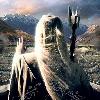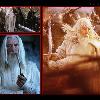

Tags: The Lord Of The Rings View |
Tags: The Lord Of The Rings View |
The Lord of the Rings is an epic high fantasy novel written by philologist (Philology) and Oxford University (University of Oxford) professor J. R. R. Tolkien. The story began as a sequel to Tolkiens earlier, less complex childrens fantasy novel The Hobbit (1937), but eventually developed into a much larger work. It was written in stages between 1937 and 1949, much of it during World War II. Although known to many readers as a trilogy, the work was initially intended by Tolkien to be one volume of a two-volume set along with The Silmarillion; however, the publisher decided to omit the second volume and instead published The Lord of the Rings in 1954-55 as three volumes containing a total of six books, rather than one, for economic reasons. It has since been reprinted numerous times and translated into many languages (translations of the Lord of the Rings), becoming one of the most popular and influential works in 20th-century literature.
The title of the book refers to the storys main antagonist, the Dark Lord Sauron, who had in an earlier age created the One Ring to rule the other Rings of Power, as the ultimate weapon in his campaign to conquer and rule all of Middle-earth. From quiet beginnings in the Shire (Shire (Middle-earth)), a hobbit land not unlike the English countryside, the story ranges across Middle-earth following the course of the War of the Ring through the eyes of its characters, most notably the hobbits, Frodo Baggins, Samwise Gamgee (Sam), Meriadoc Brandybuck (Merry) and Peregrin Took (Pippin), but also the hobbits chief helpers: Aragorn, a ranger, and Gandalf, a wizard.
Along with some of Tolkiens other works, The Lord of the Rings has been subjected to extensive analysis of its themes (Themes in "The Lord of the Rings") and origins. Although a major work in itself, the story was only the last movement of a larger work Tolkien had worked on since 1917, in a process he described as mythopoeia (Mythopoeia (genre)). Influences on this earlier work, and on the story of The Lord of the Rings, include philology, mythology, religion and the authors distaste for the effects of industrialization, as well as earlier fantasy works and Tolkiens experiences in World War I. The Lord of the Rings in its turn is considered to have had a great effect on modern fantasy; the impact of Tolkiens works is such that the use of the words "Tolkienian" and "Tolkienesque" has been recorded in the Oxford English Dictionary.
The enduring popularity of The Lord of the Rings has led to numerous references in popular culture, the founding of many societies by fans of Tolkiens works (Tolkien fandom), and the publication of many books about Tolkien and his works. The Lord of the Rings has inspired, and continues to inspire (Works inspired by J. R. R. Tolkien), artwork, music, films and television, video games (Middle-earth in video games), and subsequent literature. Award-winning adaptations of The Lord of the Rings (Adaptations of The Lord of the Rings) have been made for radio, theatre, and film (Lord of the Rings film trilogy).
Books: 'Volumes:'',The Fellowship of the Ring,The Two Towers,The Return of the King
Author: J. R. R. Tolkien
Language: English
Genre: High fantasy,, Adventure novel,, Heroic romance
Publisher: Geo. Allen & Unwin (Allen & Unwin)
Release Date: 1954 and 1955
Media Type: Print (hardback and paperback)
Pages: 1216 pp (total pages)
Preceded By: The Hobbit


